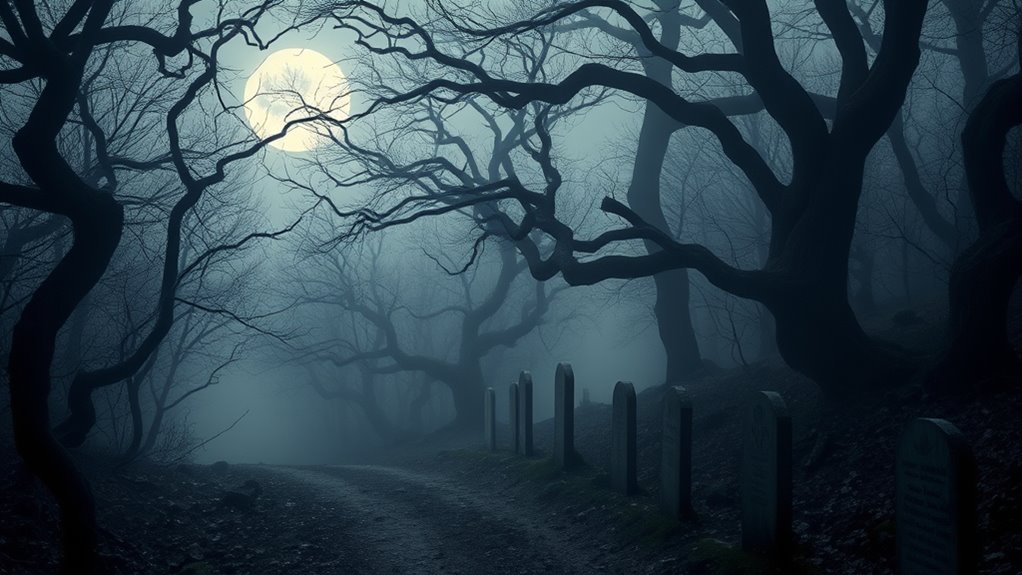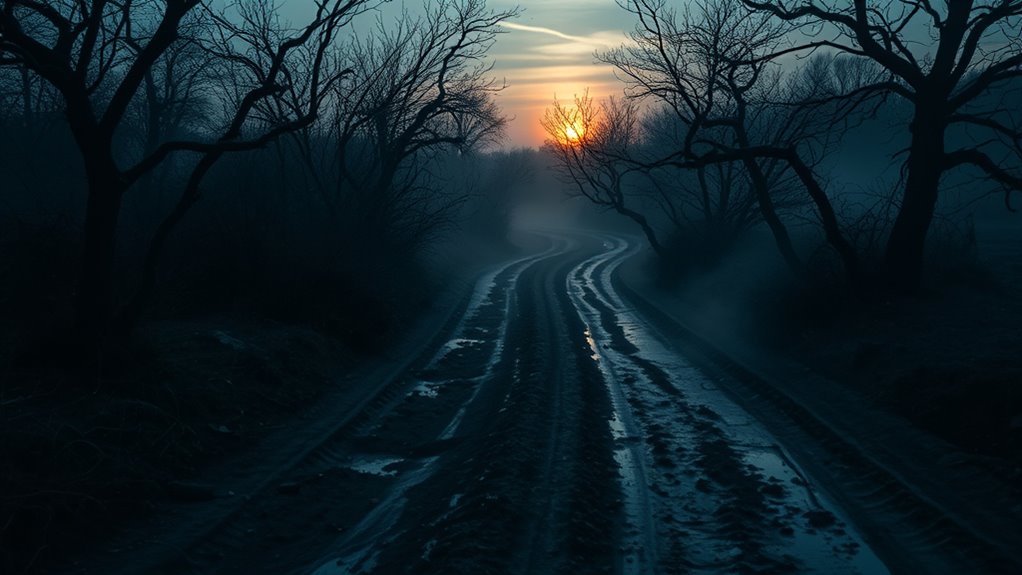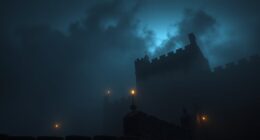Corpse roads and ghost paths are ancient routes with deep spiritual meaning, originally used for transporting the dead to burial sites. These paths serve as sacred boundaries between the living and the dead, often marked by rituals and legends. Over time, stories of spectral encounters and supernatural events grew around them, reinforcing their haunted reputation. If you explore further, you’ll uncover how these routes symbolized more than transit—they embodied beliefs, fears, and hopes surrounding life and death.
Key Takeaways
- Corpse roads and ghost paths originated from practical routes used to transport the dead, later gaining spiritual significance.
- These paths served as sacred corridors linking burial sites and communities, symbolizing boundaries between life and death.
- Rituals and prayers along these routes were performed to protect travelers and honor the spirits of the deceased.
- Legends of spectral sightings and ghostly phenomena reinforced their supernatural reputation and cultural importance.
- Over centuries, these routes became enduring symbols of spiritual journeys, community identity, and the connection between worlds.

Throughout history, many communities relied on designated routes known as corpse roads and ghost paths to transport the dead to burial sites. These routes weren’t just practical pathways; they carried deep cultural and spiritual significance. As you walk along these routes, you might imagine the solemn funeral processions that once moved through quiet countryside or winding village streets. These processions were more than a final farewell—they were rituals believed to help guide the soul to its resting place, ensuring safe passage beyond this world. Over time, tales grew around these paths, giving rise to spectral legends that persisted for generations. People whispered about ghostly figures seen along the routes or strange sounds echoing through the night, reinforcing the idea that these paths were haunted by spirits of the departed or restless entities. The standardized communication of these routes helped communities maintain their spiritual beliefs and cultural identity over centuries.
Throughout history, corpse roads and ghost paths carried spirits and stories, blending ritual, remembrance, and spectral legends beyond the mortal realm.
The origins of corpse roads are rooted in practical necessity, but their meaning deepened with spiritual beliefs. In many cultures, it was essential that the dead be transported along specific routes to avoid disturbing the living, or to prevent malevolent spirits from interfering with the journey. These routes often connected remote hamlets, churches, or burial grounds, acting as sacred corridors that separated the world of the living from that of the dead. Because of their sacred status, people believed that these paths held power to protect travelers from evil spirits or spectral legends that could cause harm or mischief. Many communities even established rituals or prayers to be performed along these routes, further emphasizing their spiritual importance.
Over centuries, ghost stories and spectral legends became intertwined with these routes, transforming them into sites of supernatural tales. Sightings of ghostly figures in funeral processions, the sounds of mourning or clanking coffins echoing in the night, and unexplained apparitions along these paths fed local lore. Such stories often served as cautionary tales, warning villagers to respect the sacred routes or to avoid them after sunset. These legends reinforced the idea that the paths were not just physical routes but gateways to the supernatural domain. They embodied a collective memory of the community’s fears, hopes, and respect for the dead, making them enduring symbols of spiritual journeys and the mysteries that lie beyond life.
Frequently Asked Questions
Are Corpse Roads Still Used Today in Any Regions?
You won’t find corpse roads still used today in most regions, but some rural communities maintain traditions rooted in medieval funeral customs. These old paths served as essential routes for rural transportation of the deceased, connecting villages to cemeteries. While modern transportation has replaced them, a few remote areas preserve these routes for cultural or ceremonial reasons, keeping the history of corpse roads alive in local traditions.
How Did Ancient Communities Decide the Routes for Ghost Paths?
You see, ancient communities selected ghost paths through careful consideration of cultural cues and geographical influence. They believed certain routes held ritual significance, guiding spirits safely to sacred sites or cemeteries. These paths often followed familiar features like forests, rivers, or ridges, reflecting their spiritual and practical purpose. By blending belief with landscape, they created routes that honored tradition while respecting the terrain, shaping ghost paths that endured through generations.
Do Corpse Roads Have Any Legal Protections or Protections?
You might wonder if corpse roads have any legal protections. Generally, rights enforcement is limited, and these routes often lack formal preservation efforts. Local authorities rarely recognize them officially, making it difficult to safeguard these historic paths. If you’re interested in their preservation, you can advocate for local or national efforts, but currently, protections are minimal. Supporting community initiatives can help ensure these important cultural routes are remembered and maintained.
What Are the Most Famous Ghost Paths Historically Documented?
You’ll find that the most famous ghost paths, like the Pilgrims’ Way in England or the Via Sacra in Rome, have roots deep in medieval folklore and pilgrimage routes. These paths gained notoriety for their eerie tales and spiritual significance. People historically documented these routes for their mystical associations and sacred journeys, making them enduring symbols of faith, mystery, and the supernatural that continue to fascinate today.
Are There Modern Equivalents to Corpse Roads in Urban Areas?
Yes, in urban areas, modern infrastructure sometimes echoes corpse roads through stories of haunted alleyways or abandoned subway tunnels. Urban legends often describe these eerie routes where spirits are said to linger, creating ghost paths within city landscapes. You might hear locals talk about these mysterious passages, blending folklore with city development. While not literal corpse roads, they serve a similar cultural role, connecting past legends with contemporary urban environments.
Conclusion
As you step along these ancient paths, feel the whisper of history beneath your feet, the ghostly echoes of footsteps long gone. Imagine shadows flickering in the moonlight, guiding you through the silent, winding roads where the past and present intertwine. These corpse roads and ghost paths aren’t just routes—they’re stories etched into the land, inviting you to walk where spirits once traveled and secrets still linger in the cool night air.








